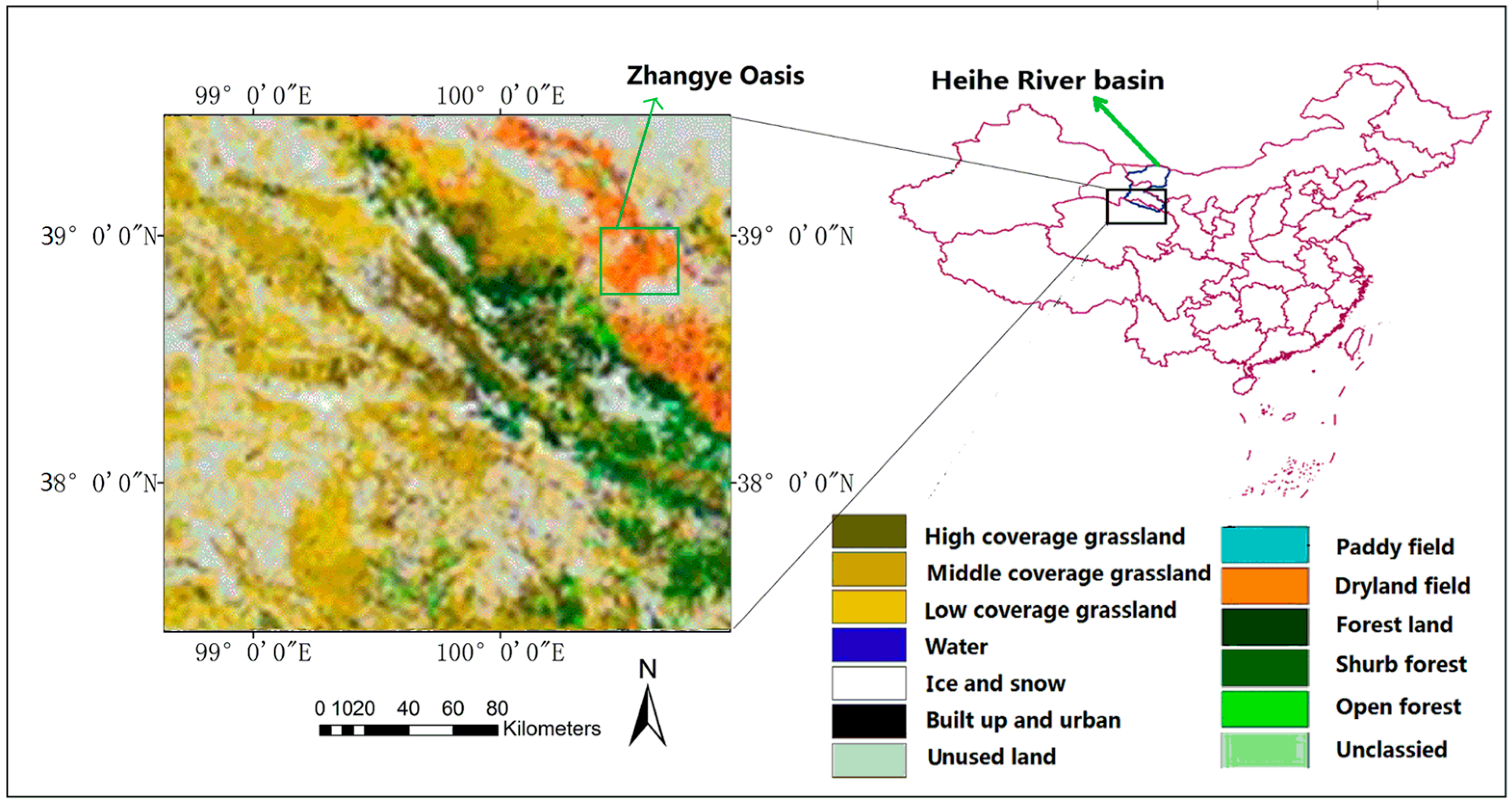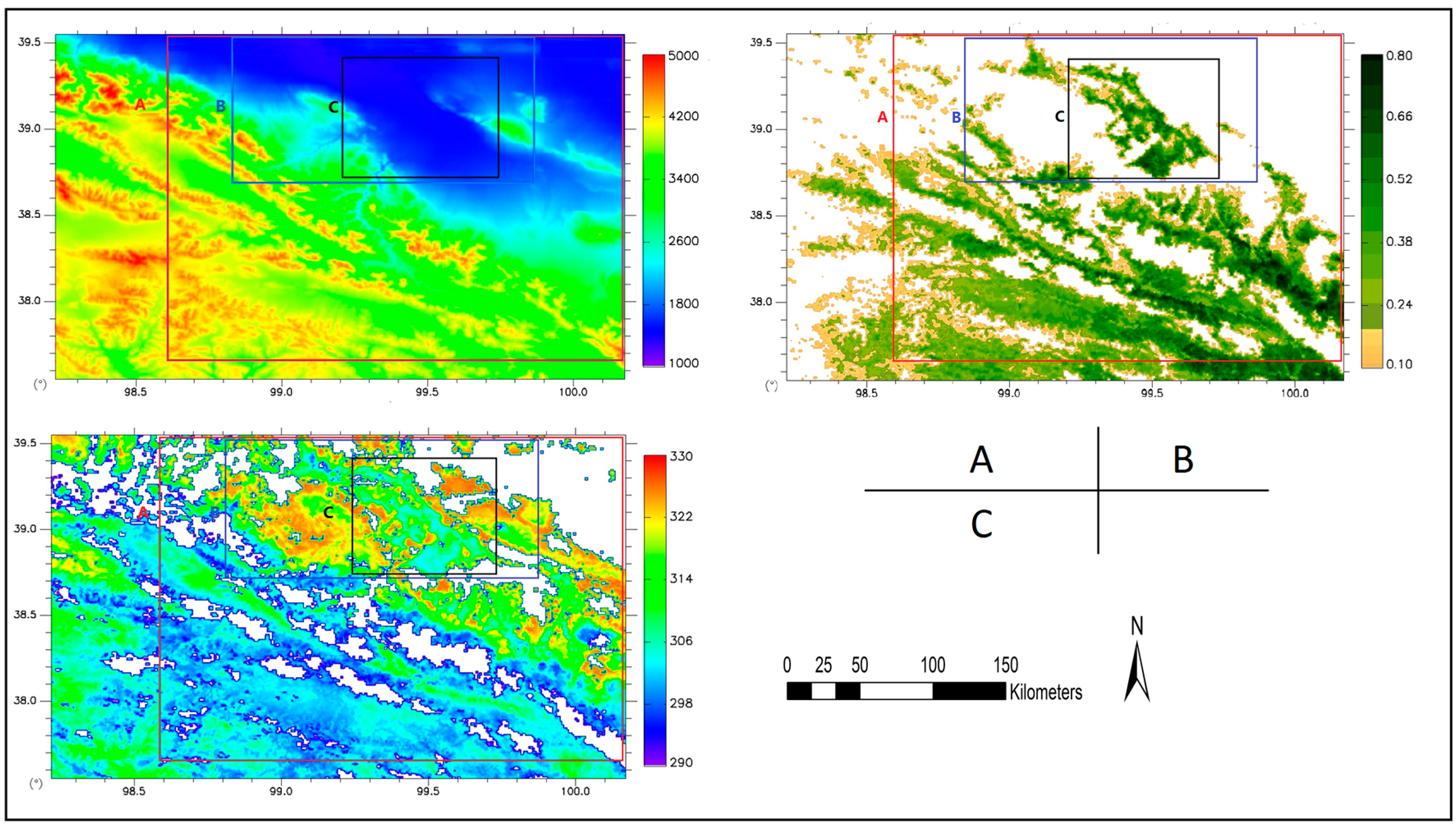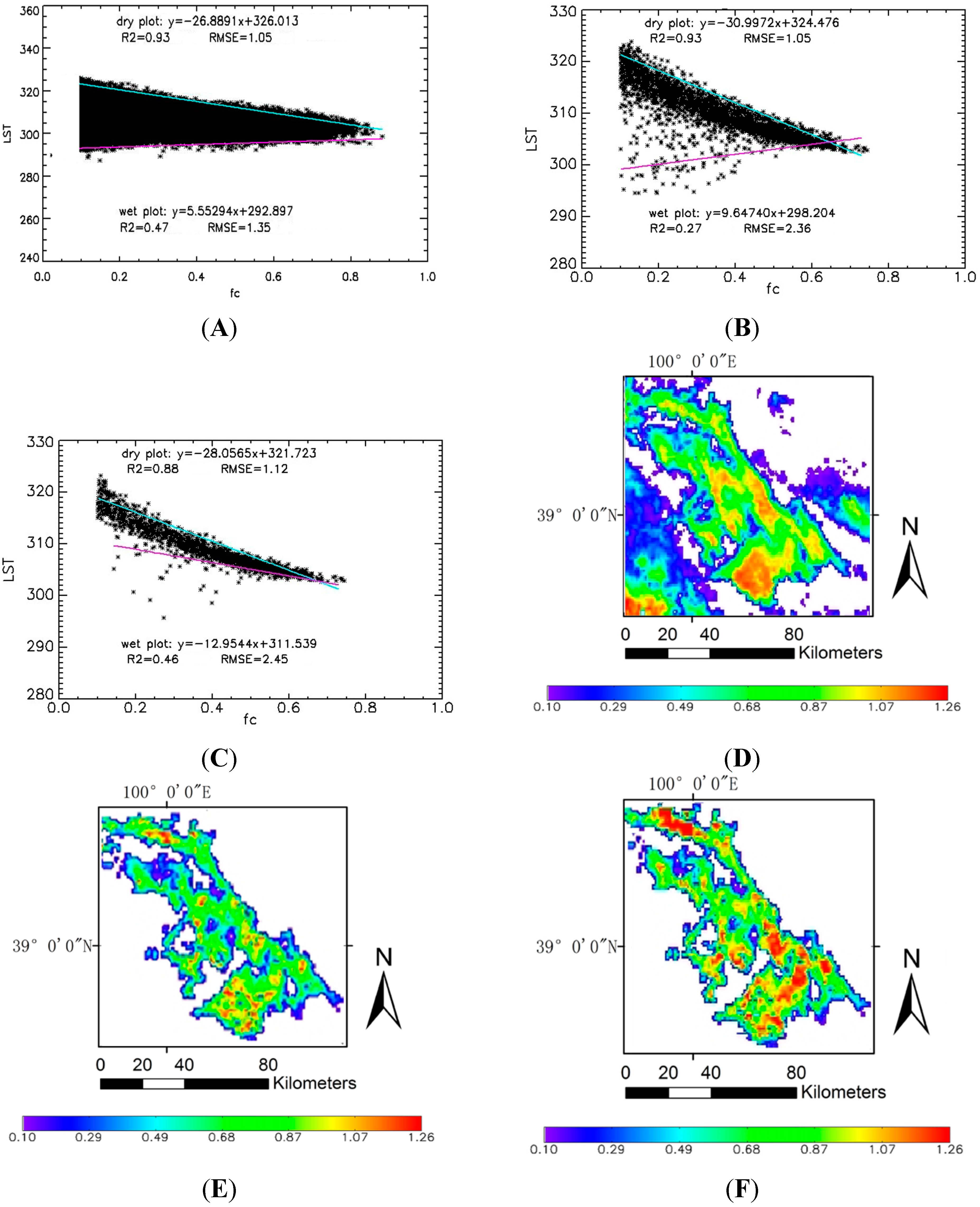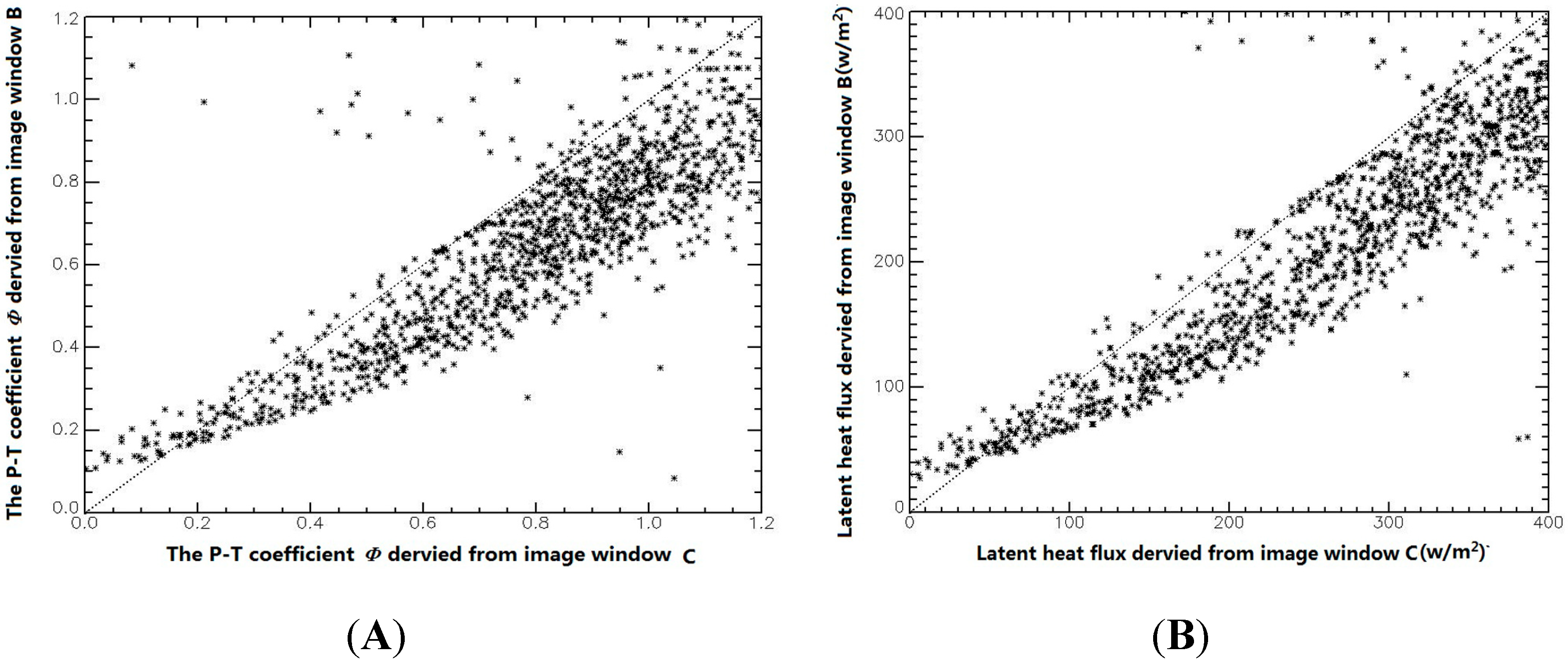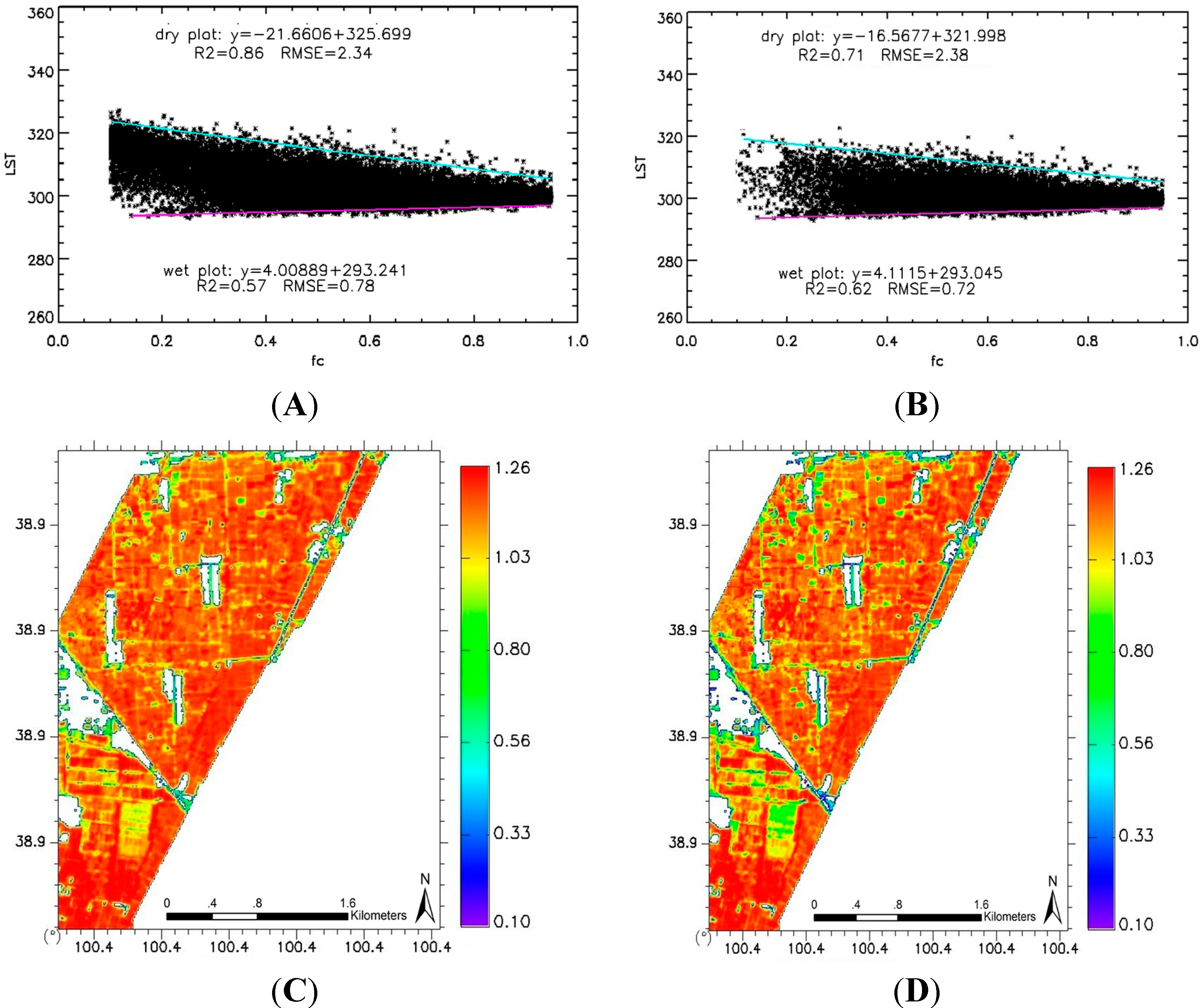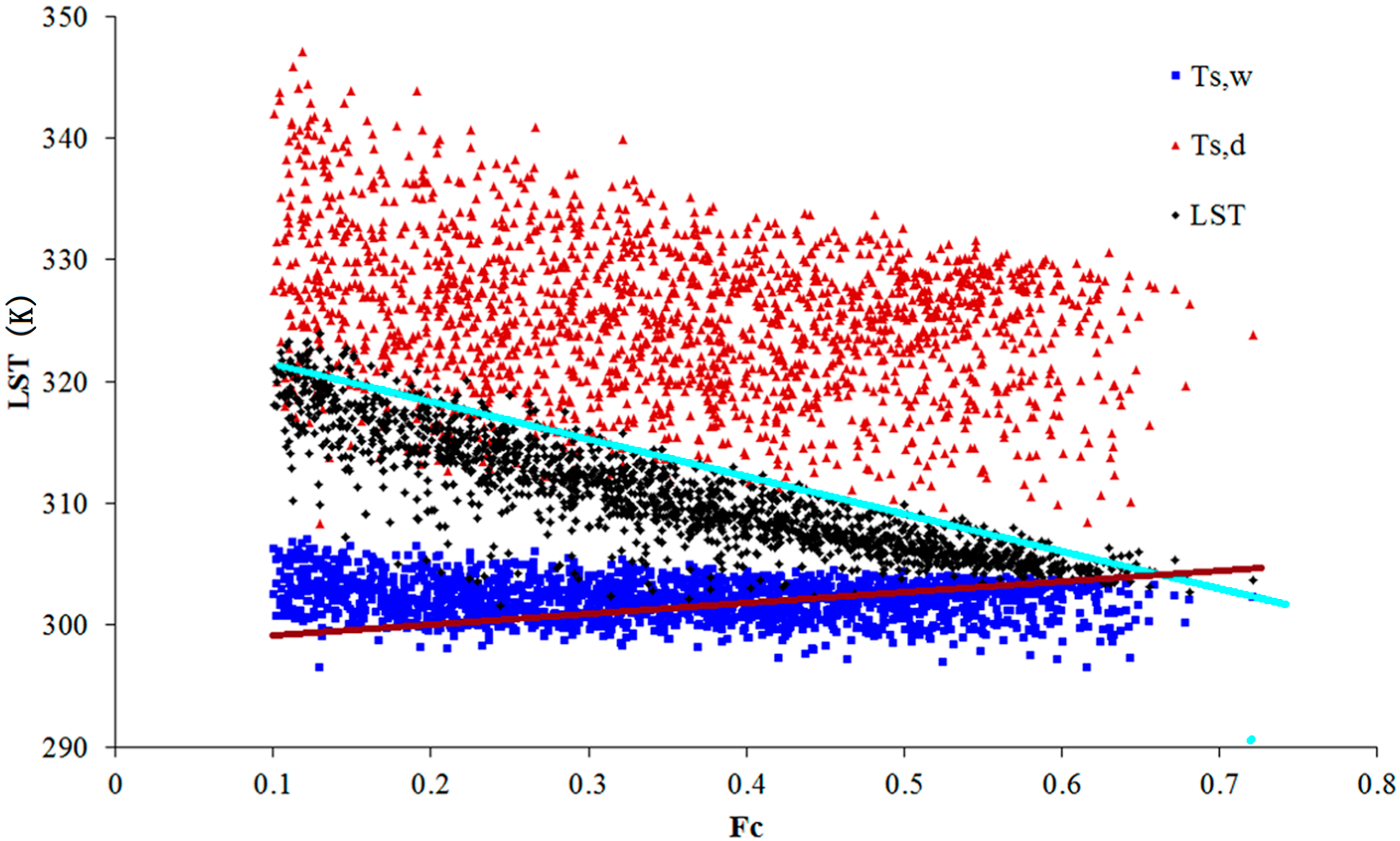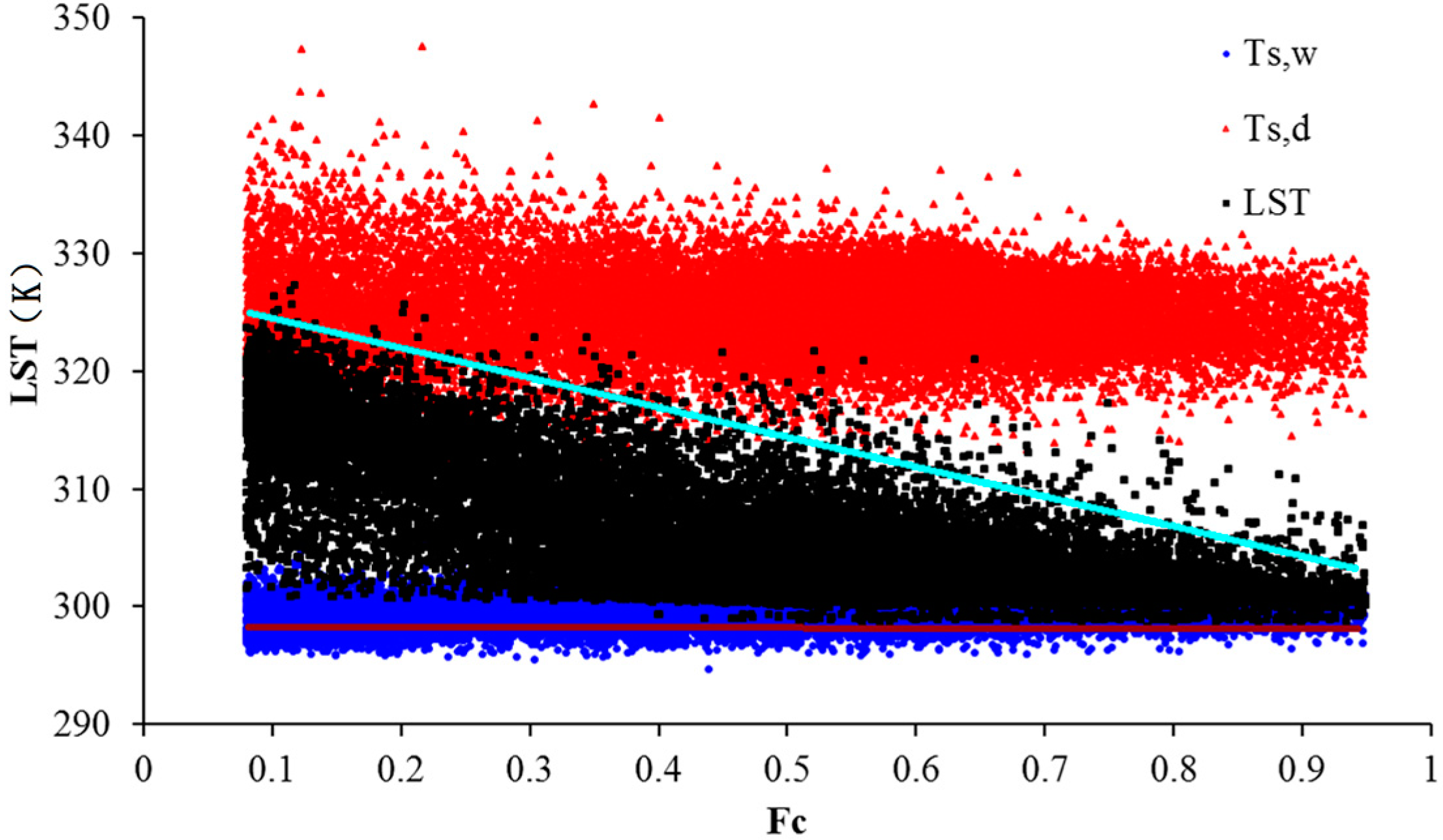The most important step in the RS-PT method is to determine the coefficient ϕ, for which the crucial point is to get the dry/wet boundaries in the LST-Fc diagram. Therefore, the discussion of this paper will focus on the identification of the dry/wet boundaries in the LST-Fc diagram and the subsequent estimation of coefficient ϕ.
4.1. Evaluation of the RS-PT Method with Moderate Resolution Data from AATSR
To evaluate the uncertainties in estimating the dry/wet boundaries and in turn their impact on the coefficient ϕ, the evaluation experiment is done by dividing the study area into three nested windows of different sizes, as shown in
Figure 3:
- -
Window A: the largest sub-region with elevations ranging from 1500 m to 5000 m and land cover consisting of forest land, cropland, grassland and unused land (e.g., Gobi and desert);
- -
Window B: the intermediate sub-region, which encompasses the middle reaches of the Heihe River basin with elevations from 1500 m to 2180 m and consist of cropland and unused land;
- -
Window C: the target area to be evaluated, which is flat with elevations ranging from 1500 m to 1730 m and land cover is dominated by cropland, located in the middle reach of Heihe River basin.
The sub-region C in
Figure 3 covering mainly part of the middle reach of the Heihe River Basin was chosen as the target area to evaluate the RS-PT method. The pixel-wise ET is calculated for this target area using RS-PT method (Equations (1), (2) and (3)) with the coefficient ϕ calculated from LST-Fc feature space constructed from the three different image windows A, B and C.
Figure 4 shows the spatial distribution of the coefficient ϕ and the corresponding LST-Fc feature space. The dry/wet boundaries, determined using statistical method, are also given in each diagram.
Figure 3.
The spatial distribution of (A) Digital Elevation Model (DEM) (unit: m); (B) Fc and (C) LST (unit: K) in the entire study area. The three rectangles (A), (B), and (C) indicate the nested windows to build the LST-Fc feature space.
Figure 3.
The spatial distribution of (A) Digital Elevation Model (DEM) (unit: m); (B) Fc and (C) LST (unit: K) in the entire study area. The three rectangles (A), (B), and (C) indicate the nested windows to build the LST-Fc feature space.
The LST-Fc diagram of region A is nearly a standard triangle feature space (
Figure 4A). Due to the elevation effect, the LST in mountain area is lower than that of cropland in the study area as shown in
Figure 3C. As a consequence, many wet pixels with low LST along the wet edge might not necessarily be well-watered pixels but can be pixels at higher elevations. Although the shape of the LST-Fc feature space in
Figure 4A seems to be perfect, the mis-defined well-watered pixels in the mountainous areas may cause errors in calculating the coefficient ϕ.
For the areas B and C, to remove the elevation effect, pixels with elevations greater than 1750 m were first masked out before constructing the LST-Fc diagrams. As shown in
Figure 4B,C, the shapes of the LST-Fc diagrams from sub-regions B and C are obviously different. We used the scatter plot to evaluate the effect of study area size on the coefficient ϕ estimation. The P-T coefficient ϕ based on the image windows B and C as well as the resulting ET are compared and presented in
Figure 5.
As shown in
Figure 5, the coefficient ϕ derived from LST-Fc space of window C is larger than that from the LST-Fc space of window B, with mean difference of 0.13 and a standard deviation (STD) of 0.27 for the difference. The overestimation is more obvious for the pixels with higher ϕ values. For the pixels with ϕ < 0.2,
i.e., near to the dry bare soil, the value ϕ from area B is lower than that derived from area C. The comparison of latent heat flux in
Figure 5B gives similar result: the latent heat flux estimated using LST-Fc space of window C is larger than that from LST-Fc space of window B with a mean discrepancy of 69.5 W/m
2 and STD of 114.7 W/m
2. In theory, the value of ϕ for a given pixel depends on the relative position of the pixel between the dry and wet edges in the LST-Fc feature space. With different spatial coverage of the study area, the respective statistical boundaries also change in the varying LST-Fc feature space (e.g.,
Figure 4B,C). Thus, the relative position of any pixel changes with the varying wet or dry edge. This leads to a varying value ϕ with the change of size and location of the windows that determine the LST-Fc feature space as shown in
Figure 4. From the above analysis, we can draw the conclusion that the difference both in the LST-Fc feature spaces and the coefficient ϕ between window B and window C is completely caused by the different size of the two windows and a resulting different range of land surface properties (e.g., Fc, LST and soil moisture).
Figure 4.
The LST-Fc feature space constructed respectively using: (
A) image window A; (
B) image window B; and (
C) image window C in
Figure 3; (
D,
E,
F)—the coefficient ϕ of the target area estimated using the three windows A, B and C in
Figure 3 for LST-Fc feature space, respectively.
Figure 4.
The LST-Fc feature space constructed respectively using: (
A) image window A; (
B) image window B; and (
C) image window C in
Figure 3; (
D,
E,
F)—the coefficient ϕ of the target area estimated using the three windows A, B and C in
Figure 3 for LST-Fc feature space, respectively.
Figure 5.
Comparison of estimated values for target area (window C) using LST-Fc feature space constructed from windows B and C respectively: (A) coefficient ϕ; and (B) latent heat flux.
Figure 5.
Comparison of estimated values for target area (window C) using LST-Fc feature space constructed from windows B and C respectively: (A) coefficient ϕ; and (B) latent heat flux.
It should be noted that the size of image window C is relative small compared with image window B, thus the range of soil moisture is narrow and the number of soil pixels with lower LST in window C is rather rare. Therefore, it is questionable that the wet boundary can be derived correctly from the LST-Fc diagram feature space constructed using the image window C.
The results show that the LST-Fc diagram does not only depend on the size of the area to build the LST-Fc feature space, but also on the ranges of the land surface Fc and soil moisture found in the area. The varying size of the sample window may lead to varying LST-Fc scatter plots and dry/wet boundaries, in turn, affect the coefficient ϕ. In addition, the area to construct the LST-Fc diagram should meet the precondition, which is to have a relatively small variation in elevation.
4.2. Evaluation of RS-PT Method with High Resolution Data from WiDAS
As the WiDSA is an airborne remote sensing sensor, the spatial coverage of WiDSA image is much smaller compared with that of satellite AATSR image. In this study, the image of WiDAS covers part of Zhangye Oasis, which is dominated by irrigated maize crops with village buildings and roads distributed in between. The WiDAS image was acquired on the same day during growing season, i.e., 7 July 2008.
Because the spatial resolution of WiDAS image is very high, the non-vegetated area (e.g., house roof, roads, pool,
etc.) could be easily identified by visualization. As the pixels of water body are characterized by lower LST and strong evaporation, they can be treated as well-watered “soil” pixels. The pixels of impervious surface have a heating effect through absorbing solar energy rapidly. Due to the lower heat capacity with respect to that of bare soil, the temperature of an impervious surface is usually higher than that of a dry bare soil. At the coarse resolution of an AATSR image, the influence of impervious surface pixels on the LST-Fc diagram is not obvious due to the mixture of different elements in a pixel. At high resolution, however, these pixels of impervious surfaces appear explicitly around point A in
Figure 1, corresponding to the maximum LST and minimal Fc. These pixels do not satisfy the definition of the dry pixel in
Section 2.1. We refer to these pixels with impervious surfaces as “erroneous dry pixels” (fake dry pixels) and the derived dry edge based on the fake dry pixels is referred to as an erroneous dry edge (fake dry edge).
The results of the estimated ϕ and LST-Fc feature space measured by WiDAS are shown in
Figure 6. The LST-Fc feature space in
Figure 6A, referred to as original feature space, is the result constructed normally with all pixels in the image. The feature space in
Figure 6B corresponds to the refined result obtained using refined feature space in
Figure 6D, that is constructed with the residual pixels after removing the erroneous dry pixels.
Figure 6.
The LST-Fc feature space constructed respectively by: (A) using the WiDAS image, denoted as original feature space; (B) using WiDAS image data without erroneous dry pixels, denoted as refined feature space. (C,D) the results of coefficient ϕ estimated from LST-Fc feature space (A) and (B) respectively.
Figure 6.
The LST-Fc feature space constructed respectively by: (A) using the WiDAS image, denoted as original feature space; (B) using WiDAS image data without erroneous dry pixels, denoted as refined feature space. (C,D) the results of coefficient ϕ estimated from LST-Fc feature space (A) and (B) respectively.
The maize was irrigated several times during the growing season. The irrigation schedule was not the same for different maize fields, this result in a relative broad range of the soil moisture for vegetation-covered pixels over this area. As a consequence, the diagram of WiDAS shows a typical trapezoid shape (
Figure 6A,B). The comparison between the original feature space (
Figure 6A) and the refined feature space (
Figure 6B) shows that the position of the erroneous dry edge is higher than that of the real dry edge in the LST-Fc diagram. This would cause errors in the calculation of P-T coefficient ϕ and ET. Analogous to
Figure 5, the scatterplots of original and refined results (
Figure 7) were used to evaluate the influence of erroneous dry pixels on the estimation of the P-T coefficient ϕ and of ET. It is obvious that the values of coefficient ϕ derived from the original feature space are higher than that from the refined feature space due to its erroneous dry edge, and it is more obvious for the pixels with relatively lower ϕ. The difference in coefficient ϕ between the original feature space (
Figure 6C) and the refined one (
Figure 6D) ranges from −0.01 to 0.46 with a mean of 0.02 and STD of 0.05, and the corresponding difference in LE varies from −35 W/m
2 to 167 W/m
2 with a mean of 15.36 W/m
2 and a STD of 23.65 W/m
2. The results in
Figure 7 demonstrate that the erroneous dry pixels cause an overestimation of both the coefficient ϕ and of the latent heat flux.
Figure 7.
Comparison of original and refined result obtained from original and refined feature space: (A) for coefficient ϕ, and (B) for latent heat flux.
Figure 7.
Comparison of original and refined result obtained from original and refined feature space: (A) for coefficient ϕ, and (B) for latent heat flux.
4.3. Assessment of the RS-PT Boundaries by SEBI
The analysis in the previous section shows that the dry/wet boundaries derived from LST-Fc feature space have significant impact on the accuracy of LE estimates. In practice, we believe that the dry/wet boundaries derived from LST-Fc feature space are reasonable if the study area covers the full range of soil moisture and Fc conditions according to the assumption that the dry/wet boundaries determined by regression in the LST-Fc feature space are very close to the theoretical values (see
Section 2). Therefore, we need to assess whether the dry/wet boundaries derived from the LST-VI feature space are reasonable and accurate.
In order to investigate the uncertainty associated with the statistical dry/wet boundaries in LST-Fc feature space, the
Ts,d and
Ts,w calculated by the SEBI model are used to investigate the position of the theoretical dry/wet boundaries. The results are presented in
Figure 8. In the LST-Fc feature space, there is only one pair of values
Ts,d and
Ts,w for all the pixels at the same Fc value, that are on the dry/wet boundaries, respectively. However, according to the SEBI concept, the
Ts,d and
Ts,w are defined for each pixel, say pixel-dependent. Particularly, difference in aerodynamic resistance will also lead to different dry and wet edges for the same Fc value. That means, for each pixel there would be a corresponding
Ts,d and
Ts,w. That is the reason why the scatter plots of the Fc and
Ts,d do not form a straight line but rather an area as shown in
Figure 8, as do the scatter points of Fc and
Ts,w.
Figure 8.
Comparison between the position of theoretical dry/wet pixels from SEBI and the dry/wet boundaries derived from LST-Fc diagram using the moderate resolution AATSR image Window B. Red points represent the Ts,d and blue points represent the Ts,w. The cyan line indicates the dry edge and purple line indicates the wet edge derived by from LST-Fc feature space.
Figure 8.
Comparison between the position of theoretical dry/wet pixels from SEBI and the dry/wet boundaries derived from LST-Fc diagram using the moderate resolution AATSR image Window B. Red points represent the Ts,d and blue points represent the Ts,w. The cyan line indicates the dry edge and purple line indicates the wet edge derived by from LST-Fc feature space.
Comparing the cluster of the theoretical (SEBI) wet pixels and the position of RS-PT wet edge in
Figure 8, the latter seems reasonable. However, there is a significant difference between the feature-space dry edge and the cluster of the theoretical (SEBI) dry pixels (
Figure 8). The feature-space dry edge is much lower than the theoretical (SEBI) dry edge. Similar to the coefficient ϕ, the value of
Λr depends on the relative position of the pixel value of surface temperature between the two extremes
Ts,d and
Ts,w in the LST-Fc scatter plot. As presented in
Figure 8, the dry edge of the LST-Fc feature space is lower than the theoretical (SEBI)
Ts, d, this is to say that
Λr derived from the LST-Fc feature space would be lower than that deduced from SEBI. The spatial pattern and frequency curves of
Λr derived from SEBI and RS-PT method over the target area are shown in
Figure 9, demonstrating that, compared to SEBI, the RS-PT method underestimates surface wetness (
i.e., smaller Λ
r) for most pixels in Zhangye Oasis. The mean discrepancy of
Λr between SEBI and RS-PT is 0.11 with a STD of 0.32. The results in
Figure 9 suggest that there are large uncertainties associated with the statistical boundaries from the LST-Fc feature space.
We also derived the theoretical dry/wet pixels for the WiDAS image Window B as shown in
Figure 10. As described in
Section 4.2, there is abundant irrigation to the maize fields in the growing season. For this reason, there should be many farmland pixels evaporating at potential ET on 7 July 2008. Therefore, the wet edge derived from the RS-PT method using LST-Fc feature space is very close to the theoretical T
s,w (
Figure 10). However, the feature-space dry edge is still far from the theoretical (SEBI) dry edge. The comparison of
Λr derived from SEBI and RS-PT is shown in
Figure 11. Compared to
Λr calculated from SEBI, the
Λr from the RS-PT method is underestimated by 0.13 with a STD of 0.04. That is because the feature space dry edge is lower than the theoretical (SEBI) dry edge (
Figure 10), as a consequence, the
Λr derived from RS-PT method is lower than that from SEBI over the WiDAS image.
Figure 9.
The spatial pattern and frequency curves of Λ
r derived from different methods over the Zhangye Oasis, using the same data as in
Figure 8: (
A) Λ
r is the result from the statistical dry/wet boundaries based on LST-Fc feature space (Λ
r-RS-PT); (
B) Λ
r is calculated based on SEBI (Λ
r-SEBI); and (
C) the frequency curves of Λ
r for (A) and (B).
Figure 9.
The spatial pattern and frequency curves of Λ
r derived from different methods over the Zhangye Oasis, using the same data as in
Figure 8: (
A) Λ
r is the result from the statistical dry/wet boundaries based on LST-Fc feature space (Λ
r-RS-PT); (
B) Λ
r is calculated based on SEBI (Λ
r-SEBI); and (
C) the frequency curves of Λ
r for (A) and (B).
Figure 10.
Comparison between the position of theoretical dry/wet boundaries (pixels) from SEBI and the dry/wet boundaries derived from LST-Fc diagram using the high resolution WiDAS image. The labels are identical to those in
Figure 8.
Figure 10.
Comparison between the position of theoretical dry/wet boundaries (pixels) from SEBI and the dry/wet boundaries derived from LST-Fc diagram using the high resolution WiDAS image. The labels are identical to those in
Figure 8.
Figure 11.
The spatial pattern and frequency curves of Λr from different methods using WiDAS data over Zhangye Oasis on 7 July 2008: (A) Λr is obtained using the LST-Fc feature-space (Λr_RS-PT); (B) Λr_SEBI is obtained based on SEBI (Λr-SEBI); and (C) the frequency curves of (A) and (B).
Figure 11.
The spatial pattern and frequency curves of Λr from different methods using WiDAS data over Zhangye Oasis on 7 July 2008: (A) Λr is obtained using the LST-Fc feature-space (Λr_RS-PT); (B) Λr_SEBI is obtained based on SEBI (Λr-SEBI); and (C) the frequency curves of (A) and (B).
Note that the
Λr derived from RS-PT shows quasi Gaussian distribution but the SEBI-estimated
Λr show asymmetric distribution peaked around 0.56 in the frequency curves (
Figure 9C). The main reason for this is that the
Λr associated with parameter ϕ derived from RS-PT is calculated using interpolation between 0 and 1; on the contrary the SEBI-estimated
Λr completely depends on the environmental situation for each pixel. Considering the effect of advection on the oasis, which may cause the failure of energy balance closure, the ground-measured
Λr without energy balance closure correction was adopted in current study. The ground-measured
Λr from eddy covariance (EC) measurements at the Yingke station was obtained as reference value for the maize field in the whole study area [
30]. Since it was the growing season of maize in July, the
Λr value reached 0.97 at the sensor overpass time in current study. Therefore, it is reasonable that the value of the SEBI-estimated
Λr = 0.96 for crop pixels.
From the analysis in
Section 4.2, the erroneous dry points would lead to higher dry edge. However, compared with the theoretical dry pixels in
Figure 10, the erroneous dry pixels are closer to the theoretical dry edge in this case. Therefore, the original feature space in
Figure 6B is not reasonable, but may nevertheless be closer to the actual value than the refined feature space for this case. This apparent contradiction is still caused by the limitation of the method for the dry/wet boundaries depending on LST-Fc scatter plot in the RS-PT model.

